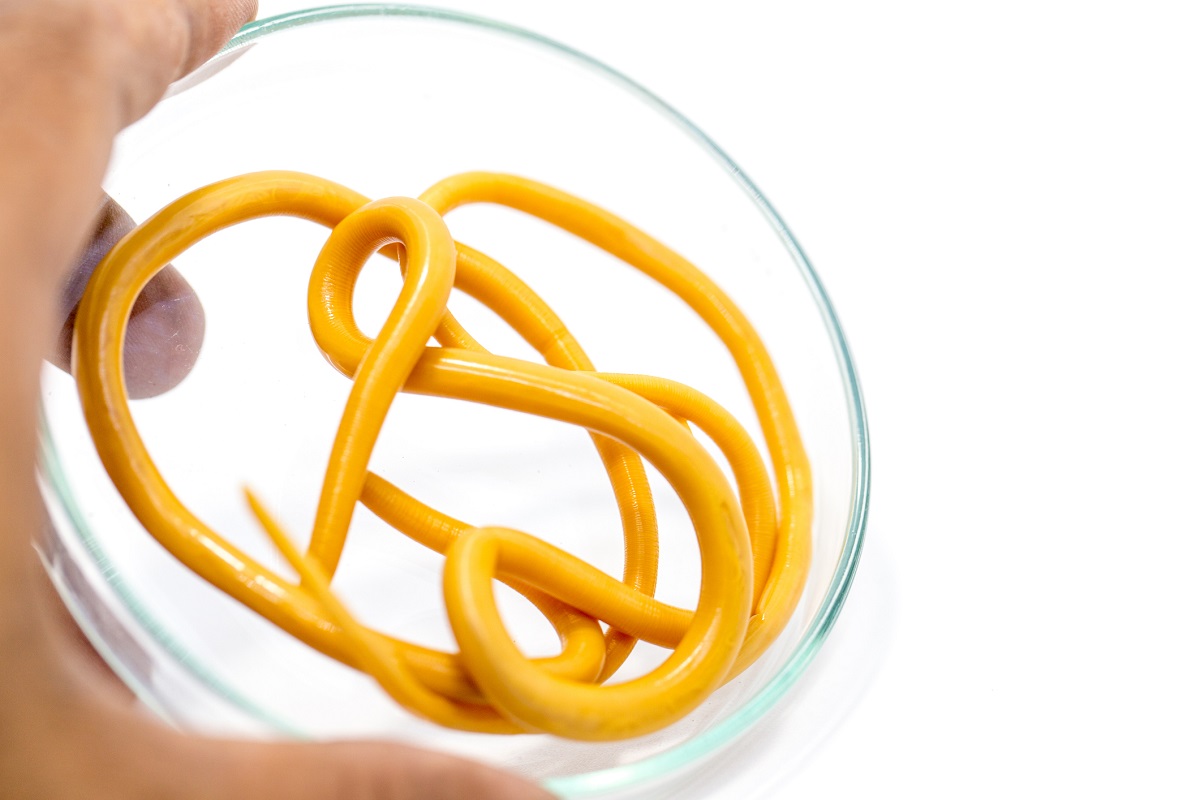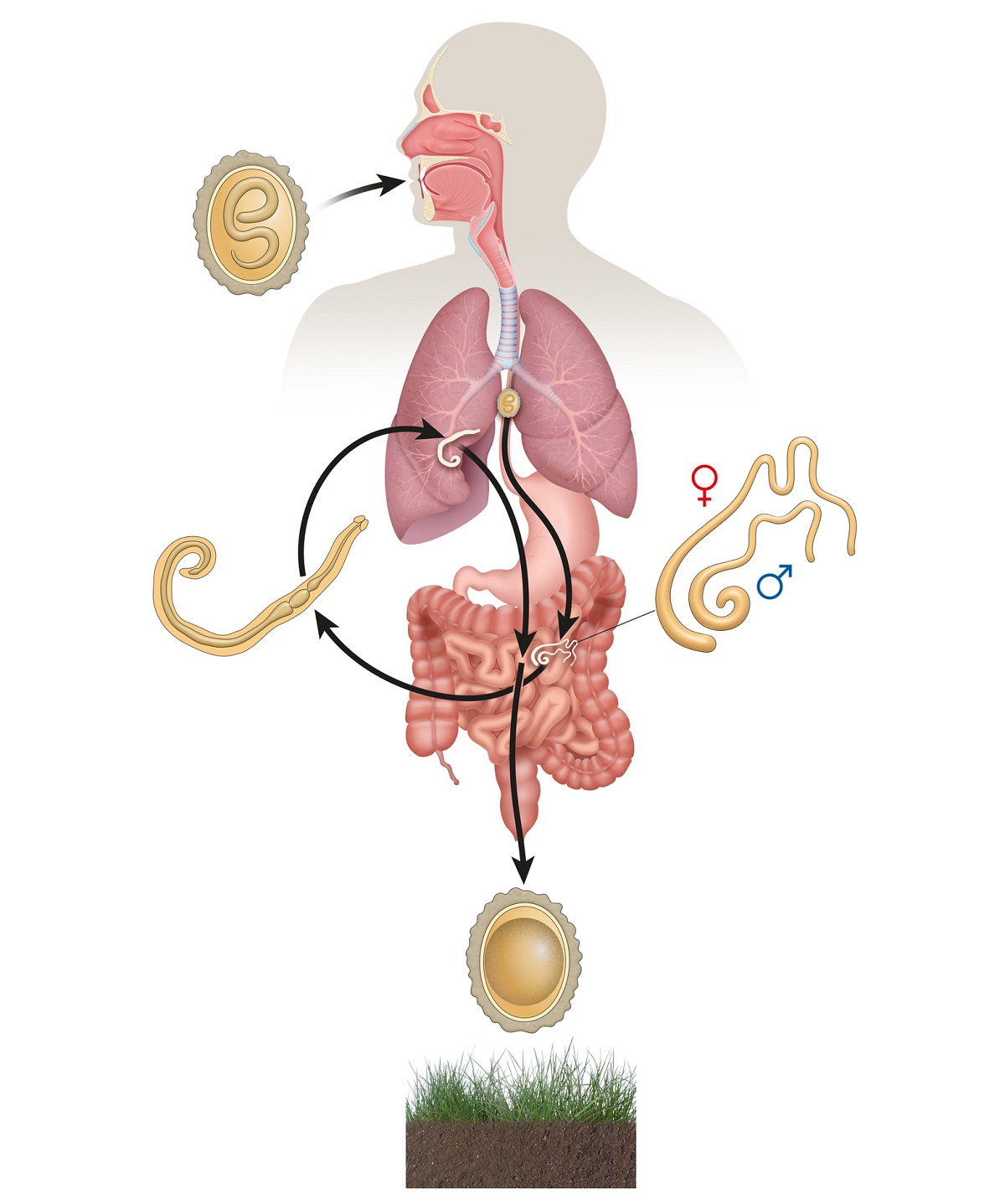- Infectious diseases in standard and intensive care: Hanuš Rozsypal, Michal Holub , Monika Kosáková
- Basics of infectious medicine: Hanuš Rozsypal
- Pediatrics: 6th Edition Translation: Muntau Ania Carolina
- Modern Obstetrics: 2nd, revised and expanded edition: Roztočil Aleš, a kolektiv
- Pediatrics for non-medical medical disciplines.
- fns.uniba.sk - Clinical Parasitology: Doc. RNDr. František Ondriska, et al.
- MUDr. František Nehaj, MUDr. Juraj Sokol, PhD., prof. MUDr. Marián Mokáň, DrSc., MUDr. Marianna Kubašková, MUC. Martin Jozef Péč, MUDr. Michal Mokáň, Phd., prof. MUDr. Peter Galajda, CSc.
- healthychildren.org - Roundworm (Ascariasis)
- stanfordchildrens.org - Roundworm Infection in Children
- mayoclinic.org - Ascariasis
Ascariasis, hookworm, childhood roundworm: What are its causes and symptoms?

Childhood roundworm, or hookworm, is a parasitic disease. The disease is caused specifically by the hookworm parasite, which has entered the body most often through ingestion of contaminated food.
Most common symptoms
- Malaise
- Feeling of heavy legs
- Chest pain
- Abdominal Pain
- Headache
- Limb pain
- Belly button pain
- Spirituality
- Fever
- Increased body temperature
- Cramps in the abdomen
- Nausea
- Diarrhoea
- Bloating - flatulence
- Indigestion
- Malnutrition
- Right Flank Pain
- Dry cough
- Fatigue
- Vomiting
- Coughing up mucus
- Coughing up blood
- Stuck winds - stopping the outflow of gases
- Yellowish skin
Characteristics
A parasite is an organism (a parasite) that lives at the expense of another organism.
Parasitic worms are organisms with developed nervous, digestive, excretory and reproductive systems.
Brief classification of the species of parasitic worms inhabiting the human body
According to their shape, worms are divided into flat and rounded.
Flat worm - Plathelminthes
Flukes - Trematoda
They penetrate the skin after bathing in hazardous waters.
They can parasitize in the digestive or respiratory tract or anywhere else.
The first manifestation is a skin rash with marked itching, swelling, and enlarged lymph nodes, just a few hours after infection.
Later on, fever, fatigue, headache, limbs, abdominal pain and diarrhoea set in.
Tapeworm/Teniasis - Cestodes
Adults parasitize the intestine and their larvae parasitize the organs of the body, which cause different symptoms depending on their colonization.
Symptoms are:
- headache
- epileptic seizures
- paralysis of the limbs
- visual disturbances
- excessive muscle tension
- nodules in the chest and upper limbs
Roundworm - Nemathelminthes
- They are round in cross-section
- They live freely in soil and water, but also on plants and animals
- Their digestive system consists of an oral opening through which they suck the nutrients needed for their growth, and ends in an anal opening
Enterobius vermicularis
It is cylindrical or filamentous in shape, whitish in colour.
The male is 2-5 mm long, the female 8-13 mm long.
They are visible on the stool shortly after defecation.
Manifestation:
- intense itching around the rectum where the roups lay their eggs
- children are restless, restless
- abdominal pain
- nausea
- vomiting
- bedwetting
Human Thin-headed Fritillary - Trichuris trichiura
They are cone-shaped with a hair-like constriction in the head part, which they attach to the wall of the large intestine.
Their colour is light pink.
The male is 30-45 mm long and the female 35-50 mm long.
The disease may present without symptoms or as digestive problems.
Manifestation:
- pain in the upper abdomen
- lack of appetite
- abdominal enlargement
- nausea
- vomiting
- increase in temperature
- headache
- dizziness
- insomnia
- chronic diarrhoea with mucus or blood
Human hookworm - Ankylostomiasis, Ancylostoma duodenale, Necator americanus
It is cylindrical in shape.
It attaches to the mucous membrane of the small intestine through the mouth opening and damages the blood vessels of the mucous membrane with its teeth.
The male measures 8-11 mm, the female 10-13 mm.
Manifestation:
- skin symptoms, itching of parts of the skin with dermatitis
- rarely with coughing
- nausea and vomiting
- a burning sensation in the pharynx may occur after eating contaminated vegetables
- increased salivary secretion
- abdominal pain, abdominal enlargement
- foul-smelling diarrhoea that is coloured red to black
- blood in the stool
Intestinal snakes - Trichostrongylus spp, Strongyloides stercoralis
Parasitic on mammals (cats, dogs...) and can be transmitted to humans.
Parasitic in the stomach, small intestine.
The eggs are expelled from the body through the stool.
Depending on the entry of the larva into the organism, symptoms are manifested:
- Skin - allergic skin reactions
- Penetration into the lungs - choking cough, blood or larvae in the sputum
- After penetration into the digestive tract - manifested by inflammation of the intestine, large mucus production, abdominal pain, nausea, vomiting, diarrhea
Ascaris lumbricoides - hookworm, child roundworm
Ascariasis, roundworm, hookworm
Baby roundworm is one of the largest nematodes. Its length is approximately 10-30 cm.
The female roundworm is larger than the male.
The body of the nematode is pointed at both ends. It is pale yellow in colour and has fine stripes on the surface. In the air it is pinkish in colour.

The roundworm parasitizes the small intestine during its life.
In humans, it can survive for up to two years directly in the small intestine.
The incubation period (the time between infection and the first symptoms) is usually 1-3 weeks.
The source of infection is an infected person who excretes the eggs in the faeces.
The route of infection is oral-fecal. You can become infected after eating contaminated food with helminth eggs. The most common route of infection is vegetables or fruit fertilised with human faeces.
Children are more at risk of infection than adults. All they have to do is put dirty hands in their mouths from contaminated soil with eggs.
The life cycle of roundworms in the human body is complex.
The developmental cycle of the roundworm
Their entire life cycle takes place in the human body.
Ingestion
A person can become infected by ingesting the eggs through the mouth. This can occur through infected vegetables, fruit and food with eggs stuck on them. Infection is also transmitted through dirty hands, contact with infected soil and drinking water.
Migration
After ingestion, the eggs migrate to the stomach, whereby gastric enzymes disrupt the egg membrane. Specifically, enzymes that break down and aid in the absorption of proteins. In the small intestine, the larvae are then released from the eggs and their casings.
After hatching, the larvae penetrate the intestinal mucosa. They travel into the bloodstream and liver veins, where they stay for 3-4 days.
Their next journey takes them to the heart and pulmonary veins, where they stay for 7-10 days.
From the pulmonary veins, they enter the bronchi and the trachea into the larynx and pharynx, where they are swallowed again. Alternatively, some are coughed up.
Maturation
After swallowing, they re-enter the intestine. At this time they are approximately 1.6 mm long.
The larva molts twice during its journey.
In the small intestine, where it began its journey, it reaches maturity between 6 and 10 weeks.
Total development takes 50-80 days and adult nematodes live for 8-20 months in the intestine.
The helminths feed on the nutrients taken in from food needed for their growth and development and produce waste substances and toxins.
It is rare for a nematode to stray during its development and cross the placenta into the mother's foetus.
Reproduction
A female nematode can lay up to 200 000 eggs a day. The eggs laid by the female nematode leave the body through bowel movements and subsequent faeces into which they are mixed.
The eggs live in faeces-contaminated soil.
Eggs that have been fertilised must remain in the soil for 2-4 weeks before they become infective. They are viable in the soil for 5-12 years. They can tolerate temperature differences of -20 to +50 °C.
Roundworm in pregnancy
The occurrence in pregnancy is risky. They have a high ability to penetrate all tissues, up through the placenta into the fetus, where the brain ventricles can be damaged. This can cause hydrocephalus in the fetus.
Read also our magazine articles:
Causes
Human-to-human transmission is not possible.
Infection can only occur through contact with soil, food or water mixed with human faeces containing ascariasis eggs.
The eggs hatch into larvae in the small intestine which travel through the body. They return to the intestine where they reach maturity.
The biggest risk is lack of hygiene and fertilisation of the soil with human excrement.
Prevention
- Take extra care when eating fruit and vegetables in areas where the soil may be contaminated with faeces
- Wash, peel and cook fruit and vegetables thoroughly before consumption
- Wash hands thoroughly with soap and water after being outdoors, before handling and eating food and after leaving the toilet
Symptoms
In most cases, their occurrence is manifested only by weak symptoms with a feeling of abdominal pain around the navel, nausea and cramps.
Symptoms are mainly manifested by the stage of development of the nematode
Lung stage
The pulmonary stage (larval stage) occurs 10-20 days after infection. It presents with symptoms such as increased temperature to fever, dry cough, headache and limb pain, Loffler's infiltrate and eosinophilia (visible pulmonary effusion and increased number of white blood cells, a type of eosinophil) with manifestations such as dyspnoea, persistent cough, shortness of breath, wheezing, chest pain, fatigue.
Symptoms appear 9-12 days after infection and last 3-6 days.
After a few days, allergic reactions such as swelling, itching may occur.
After 10-14 days in the lungs, the larvae travel to the throat where they are subsequently coughed up or swallowed.
The intestinal phase
The intestinal phase is 6-8 weeks after infection. It is manifested by abdominal pain.
Roundworm larvae mature in the small intestine. Adult worms live until they die in the intestines.
Adult roundworms require nutrients for growth and deplete the human body of vitamins A, C and minerals. They also affect the digestion of lactose, causing milk intolerance.
They damage the wall of the intestine, which they can even perforate, penetrating the abdominal cavity and causing purulent peritonitis.
A roundworm infection can cause symptoms such as:
- Abdominal pain.
- Nausea and vomiting
- Diarrhoea or blood in the stool
- Indigestion
Symptoms manifested in children:
- Dull abdominal pain
- Coughing
- Increased temperature
- Pallor
- Nausea
- Weight loss or arrest in growth
- Fever
- Wheezing
- Worms in the intestine expelled through stool
- Worms coming out of the nose or mouth when coughing
- Worms found in vomit when vomiting
By the toxic influence of the childhood helminth, the following may occur:
- Headache
- Cramps
- Hysteria
- Delirium
- Epileptic seizures
Complications
Obstructive ileus is caused by intestinal obstruction due to the presence of large amounts of roundworms that have blocked the intestine.
Pancreatitis, appendicitis. Their cause lies in the movement of the roundworm into the bile duct, the pancreatic duct or the appendix duct.
In children, failure to thrive in development occurs.
Read also the article:
Diagnostics
In some cases, it is possible to see nematode larvae in the stool or in the vomit, on the basis of which a person visits a doctor.
The most certain examination in diagnosis for evidence of eggs is microscopic examination of the stool.
This is followed by a laboratory examination of the blood for a blood count. This shows elevated levels of white blood cells, called eosinophils.
A lung X-ray shows the presence of Loffler's eosinophilic infiltrate (effusion on the lungs).
The sputum (mucus content coughed up from the lungs) is examined microscopically on day 5-6. Eosinophils (a type of white blood cell) and bloody sputum are present.
Abdominal radiographs are taken to confirm the presence of a cluster of helminths in the intestine.
If a helminth is suspected in the bile duct, pancreas or liver, an ultrasonographic examination is performed.
In the presence of roundworm, all family members as well as the infected child's playmates are examined.
Upon confirmation of the parasitic disease, the hygiene of the latrines is supervised and they are disinfected with 50% chlorine lime.
If there are multiple children in the collective, a sample is taken from the sandpit for the presence of roundworm eggs.
Course
Its course depends on the general state of health of the person and the amount of the infectious dose.
The course is asymptomatic at low levels of infection and helminth colonization.
After ingestion of infected food, the eggs pass from the stomach into the small intestine where the larvae hatch.
The larvae pierce the wall of the intestine and penetrate the intestinal wall into the blood vessels. They enter the blood or lymphatic circulation.
They pass through the bloodstream to the liver and then to the lungs, where they bore their way into the lung bronchi and begin to grow into worms.
They move upwards through the respiratory tract into the larynx, where they are subsequently coughed up or swallowed again. In this way, the early mature roundworms reenter the digestive tract.
In the small intestine, they mature. Their lifespan is 1-2 years.
The female child roundworm lays up to 200 000 eggs a day, which are subsequently excreted in the faeces. They enter the sewage system and the soil, where, after contamination, they enter the digestive tract of the next person.

How it is treated: Ascariasis - hookworm, childhood roundworm
What is the treatment of ascaridosis, human hookworm: Medications, antiparasitic tablets
Show moreYouTube video
Ascariasis is treated by
Other names
Interesting resources










